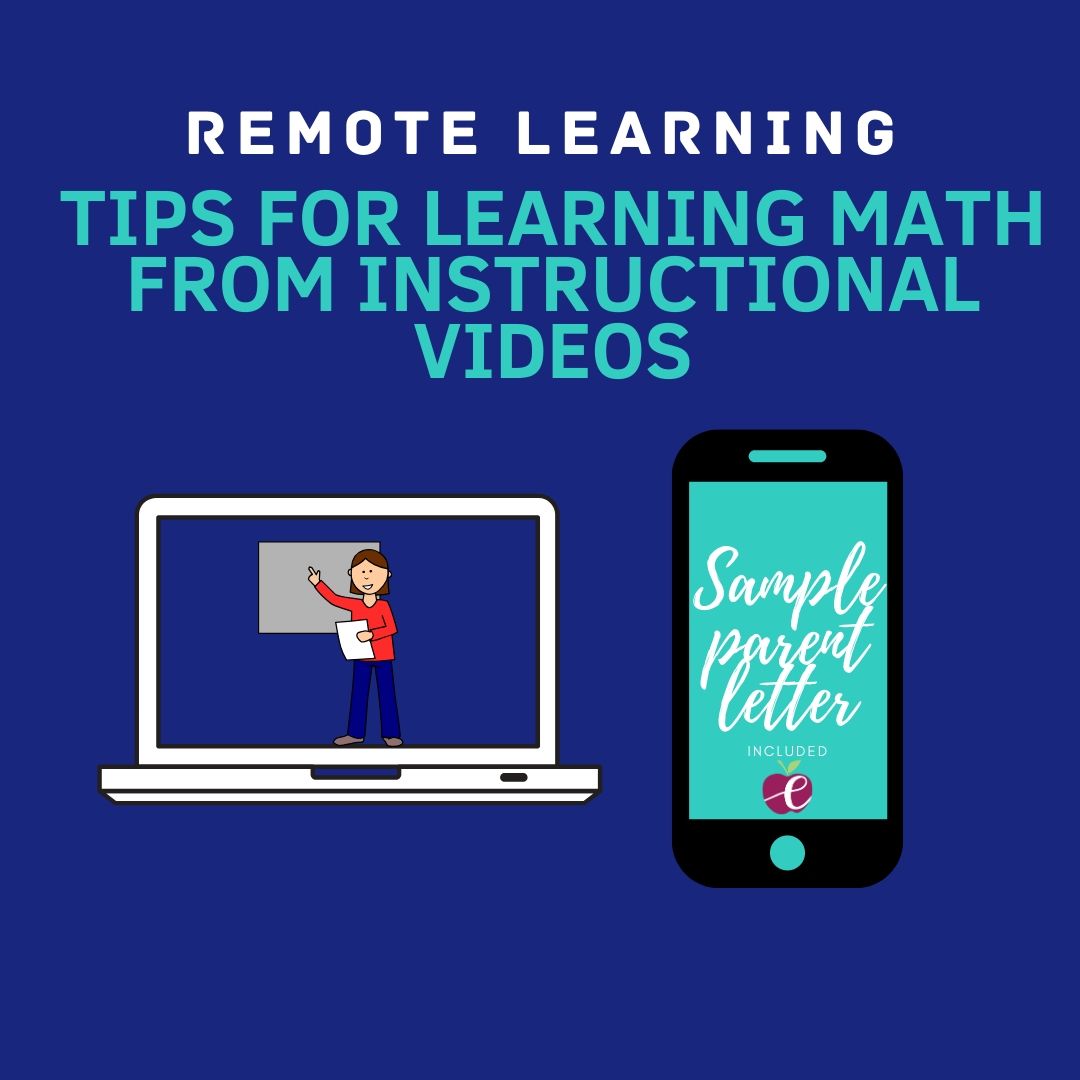
26 Apr Learning How to Learn Remotely
Disclaimer: Every teacher, just like every student, parent, and home life, has their unique challenges and circumstances of which are now also a part of their remote learning world. Not everyone is in a place where they can put these suggestions into place. BUT…if we aren’t growing, we’re dying. So, my encouragement to us all is to be better today than we were yesterday. My hope is this post helps inspire even a single step to being that little bit better tomorrow. If being better to you looks like waking up and answering emails. Go with it. If being better means putting into practice these tips, go for it. Let’s go GROW during this time…
I realized a few things this week, after doing remote learning with my own children for the 5th (?) week in a row —I think 5th, honestly, I don’t remember and it isn’t because I have endless amounts of free time (who are those people?), but more because the monotony of the day’s activities starts blurring together.
I’ve learned this week:
1. Students need help learning HOW to learn remotely as much as teachers need support knowing how to TEACH remotely.
And…
2. Our parents need help knowing how to help and what their role is or can be.
That is all. That’s enough. Mic drop. Blog post over.
Ok, not that simple. I’m picking the mic back up to explain further.
Learning and teaching remotely is like putting together Ikea furniture. If you’ve never assembled any Ikea furniture, you are one lucky person. Ikea’s directions are nearly all in pictures (and Swedish). It’s a matching game of parts, screws, etc. all in an attempt to make the final product resemble that cute piece of furniture you saw in the store that you just had to have. In this example, less is not more. I need more from Ikea. I need more directions, better labeling, and a video tutorial, ok? In fact, if you could just send over one of those adorable Swedes to assemble it for me, I’d love it even more. Not going to happen? Darn.
But doesn’t this sound like our students, or if we are honest, us? We don’t really want to struggle. We want a step by step tutorial and it’d be grand if we could skip that step and just borrow our colleague’s plans, videos, etc. This remote teaching thing is HARD. On behalf of the students and parents everywhere, this remote LEARNING thing is HARD. I won’t be showing up to make your plans for you, put together your furniture, or learn for your students. But, I will help you teach your students how to LEARN remotely. It doesn’t just happen. I’ll help you LEARN how to TEACH remotely. I do believe the lessons we learned while in the classroom can help us understand how to teach remotely.
Knowing the big picture is important. We see the picture of the furniture fully assembled. We see the recipe of the dinner at its final cooked state on the recipe card, we see the final Lego product on the Lego box. But, what we know is that isn’t all we are given. We are given a big picture (ie. learning goal) but then we need time to interact with each step. We have to read the first step, make sense of it, reread it, try it, reread it again, etc. Along the way, we are LEARNING because we are an active part of the process. We fail at the 3rd step, but only know it when we get to step 4 because the chair just doesn’t quite look right. This is learning. It is messy and non-linear.
You might have been doing this with the new technology you’ve implemented to help you teach. You have to play with it, interact with steps, rewatch Youtube tutorials, etc. You have to wrestle with the learning and because you’ve done so, the learning has been so much more lasting and meaningful. Has it been difficult? You betcha. But, friend, you’ve got to admit, you’re better for it.
Very few of us can watch a YouTube video on how to do something one time, at a glance, and then go replicate what it was teaching us. I know this to be true because LEARNING IS DOING. I can read a self-help book. Sure, I’ve taken in the learning, but I haven’t really learned it until I’ve applied it in some way to my life. The parts I apply are deeper, more lasting learning.
Our students need to interact during the teaching, not just at the end.
Our students need LESS instruction before they get the chance to interact with the learning. In many cases, we are presenting an entire lesson– recorded, or assigned, or live, etc. of a concept, then assigning an activity. It’s too much content with little interaction. If the only time students are interacting with the learning is after the lesson when they are applying, then it was too much.
As I watch my own children watch instructional videos, it becomes clear which ones they ‘endured’ because the teacher just went on and on (no matter how grand), and which ones they understood and learned from. As the teacher, I’m sure you can tell the same thing. I am talking with teachers all over the nation who are so frustrated with students not following directions. “I made a video!” “I wrote the directions!” Good for you– but now it’s time to make them better. You can give the best darn lesson of your life, but if you never stop to ask questions or stop to have students interact, how do you know it is working?
I know the videos my own children are merely enduring because…
- Immediately after the video, they ask for help. No one likes to struggle, but without the struggle, we aren’t truly learning. How many of us as parents or teachers just want to tell our kids the answer? It is so painful for both parties to struggle, but if students are used to being rescued, then they don’t engage during the learning. If they aren’t forced to interact with the video, then they likely aren’t learning — “I don’t want to put the energy into actually understanding, so I’ll endure the directions only to request or require help when it’s over.”
- When quizzed on video content, they have no idea (were we even watching the same video??).
- During the video they are multi-tasking…like hanging upside down from the couch and attempting to make baskets with their socks to the trash can– what, not your children? Must just be mine. Did I mention teaching your own children is so much harder than teaching other people’s children? (I see these distracting behaviors every day in classrooms, but when from my child, at home, one on one, I have little patience.)
Is this any different than the classroom? Not for many of us. We teach. Kids ‘endure’, then a gazillion hands are raised to receive individual help.
Unless…….
Unless you are a teacher who is inserting lots of Math Talk, inquiry, etc. into your math classrooms. In that case, you might pose a question, have students attempt it. You discuss it as a class, provide some insight, teach, then post another question. You continue to modify, inquire, and provide additional supports or questions based on the misunderstandings and understandings of students. Students are active in their learning and responsible for their learning. They weren’t merely regurigators of information given to them, they were Meaning Makers.
What if we taught the same way in our online lessons? What if we started with a prompt…how might you….. and ask students to pause and try? Then we present some ideas on video, work through a few, and stop to ask questions of students? What if we provided errors for students to think through before we directly taught how to avoid them? What if instead of telling students what to do, our students were an active part of their own learning? What if most of the ‘learning’ happened during the video and the practice or building of procedural fluency happened AFTER the video? For example, a direct teach: “A rectangle can’t be a square because all 4 of its sides aren’t equal in length. ”
Instead what if we said, “Pause the video for a moment and answer this question, based on what we know about squares and rectangles is this statement true or false and why?”
Which statement will result in surface understanding, and forgotten tomorrow, and which method will result in more meaningful learning? This doesn’t mean they will answer correctly, but they’ve caused a ripple in their brain–we’ve disrupted the equilibrium, forcing us to create some new synapses when we learn the real answer or reasoning. There is LOADS of research around the importance of mistakes in learning. When you put part ‘A’ wrong with part ‘B’ and have to figure out how they actually go together, you understand the parts better than if they would have fit together perfectly the first time.
The best learning videos all have the following in common:
- They are brief. Hence my lesson of LESS IS MORE. They are never more than 15-20 minutes in total length.
- Even in 15 minutes, the content is broken into small, manageable pieces. The ratio I believe is best is 2:1. Teachers instruct for no more than 2 minutes before having students interact, reflect, try it on their own. (note: This isn’t follow-the-leader: I do, now you copy. I want your interaction to cause a brain ripple, a forehead to scrunch…a synapse to spark.)
- Students are doing something other than listening during the video. Materials are out, notes are made, problems are attempted. See note above about what qualifies.
- Students pause and play and pause and replay parts of the videos until they get their problems correct.
- Students are having to stop the video to defend, think through non-examples, etc. before resuming video play.
- Students are frustrated during the lesson, but by the end, they’ve acquired confidence and are able to work independently. Their frustration forces them to want to hit play to figure out what they didn’t get, or got wrong, or didn’t understand.
How do we help kids learn how to learn remotely? How as teachers can our lesson structure change to meet this need?
- Provide a question for students. Make connections to prior learning, etc. (2 minutes).
- Students pause the recording and respond (in notebooks, on a google doc, in Seesaw, in Flipgrid, etc.). This work is the be turned in– not because it has to be right, but because it is the formative assessment you are using to gather how they learned throughout the lesson.
Or, if you want it to be technology-based, use PEAR DECK where students can interact with the content slide-by-slide (PearDeck is a Google add on. I literally Googled it, watched two Youtube videos on it, and could apply its basic features in all of 20 minutes).
3. Teaching resumes, giving instruction through the use of visuals, examples, and non-examples (2 minutes).
4.Students pause and reflect/respond/try.
5. Teaching resumes, giving instruction through the use of visuals, examples, and non-examples (2 minutes).
6.Students pause and reflect/respond/try.
7. The teacher collects work and evaluates student’s understanding of the learning/topic and determines if more instruction is needed on this topic, or if for day 2, 3, etc. the student can apply and practice the learning. This may require small group live sessions, or another video lesson reflecting on what was seen etc.
I have some great examples of this. I’m giving one video one below.
My friend Lisa, from Bancroft Elem. in Minneapolis Public Schools (one of my favorite schools, staff, and kids), shared a teaching video with my Facebook group. What I loved is she set up a task (very brief). She had students pause and try it on their own. She didn’t treat the video like a lecture. She treated the video like she was in front of real students.
After setting up directions, giving an example, and then an action step, she came back and was explicit, direct, and gave visuals to support the teaching. She gave another example/explanation, had students top the video and respond or reflect. Her video was recorded, so she didn’t have instant feedback, but it was designed in such a way that students were actively a part of the learning DURING the lesson. Once the work was turned in, she’d have a better idea of what she needed to do day 2.
Here is a snippet of her video. Want to see the full thing? Go here.
Ok, so you’re thinking it, I’ll just say it. OF COURSE, KIDS ARE BEATING THE SYSTEM.
“Just because you tell them to stop the video, doesn’t mean they are.”
“They can just fast forward and get the answers.”
This will happen. But our goal is to create such a great community of learners that it is expected that kids aren’t right the first time. It is expected and respected that students try problems and get them wrong as a part of the learning process. If we built this community in the classroom, we should expect it at home too. It’s not going to be perfect. It’s not going to work with every child. It won’t be enough for every kid. It will be too much for other kids. This is teaching. My goal is that we will have less frustrated parents, fewer assignments turned in that are low effort, less individual comments and emails from students saying they don’t get it, etc. I believe this is attainable when we make teaching, even videos, interactive, and create an environment where failing equals learning.
2. WE HAVE TO HELP OUR PARENTS KNOW HOW TO HELP.
Have you expressed to parents and guardians how they can help? I’m surrounded by friends, family, and community members who are trying to manage remote learning alongside all of their other responsibilities (just like you). What I hear over and over is fear-based.
“My kid doesn’t get it.”
“Is this how they acted all year?”
“I think I need to hire a tutor.”
“I have to re-explain everything.”
“I don’t get this math, how do I help them?”
As parents, I believe these statements come from a place of truly wanting to help our children and a fear that we are failing them; that our kids will be bad at math, and for some people, that we somehow passed on the ‘bad math gene.’ We are afraid to admit we don’t understand and so we, the parent or the teacher, become defensive, angry, and frustrated.
So, teachers, I want to ask you this: Have you taken the time to help parents know how to help? When students don’t get it the first time, isn’t this normal? We expect it, but do parents? Have we helped parents understand the learning process and what our role is in that process and theirs?
It is my hope that you ARE STILL providing instruction to students. If you aren’t, due to mandates given to you, then this still applies. Have you helped parents know how to help their students with packet work?
Parents, teachers, and students are stressing out EVERYWHERE, but I think it mostly has to do with not understanding the expectations or how to help.
To help, I made a sample letter to parents as well as a list of questions they can ask at home to be helpful. Although I want to help my students understand and I’m happy to teach my own children, I also have a background in teaching. As students do remote learning, WE ARE STILL THE TEACHERS, our parents are the helpers (teachers if they want and are able), so we need to help them understand their role. I think most parents think they have to be teachers now. That’s not the deal. They are partnering with us and they need to hear from us. Get the sample letter and tips to your email inbox by putting in your email here:
Let’s end with some truth bombs:
- Videos for teachers are different than videos for students. Teachers, generally, know how to learn remotely. They are aware when they’ve stopped learning or there is too much info. They can self regulate. Some videos are made for teachers. A video made for students helps them to know WHEN to stop, interact, summarize, etc.
- Some parents are asking too much of us. It has always been. Will always be. You are not free ice cream– you can’t make everyone happy.
- Some students will still not do their part to be an active learner. Happened in the classroom, happening remotely. We just keep trying new strategies until we find something that works.
- This isn’t the same as being in the classroom. We aren’t used to teaching this way. But we are capable of learning new things. We can do hard things.
- We are not film majors. Let go of perfection. Most of us HATE videoing ourselves. Your kids really don’t care, they see you every day. Do your best, just like you tell your students. Be vulnerable.
- Khan Academy videos and others on the internet are nice tutorials, but they don’t teach kids how to learn or interact remotely. If you are using these tools, you still need to teach kids how to interact with them. THEY AREN’T YOU. Go for a balanced approach with these. Your students need YOU.
- Don’t be the glass half empty teacher. If you are being Negative Nellie right now, snap out of it. Take a piece of this and move forward. We can ALL improve. There are a million reasons this won’t work with your teachers, with your students, with your parents but there is a very good reason it will — Because you continue to try and make it better each week.
What else are you doing or using (another great tech tool?) to help students learn how to learn remotely and how to interact with the content? Less is more. Let’s go build the furniture (lesson) one step at a time and have students engage with the learning while we teach, not at the end. Let’s simplify the process for parents and help them to know how to help.





Sorry, the comment form is closed at this time.